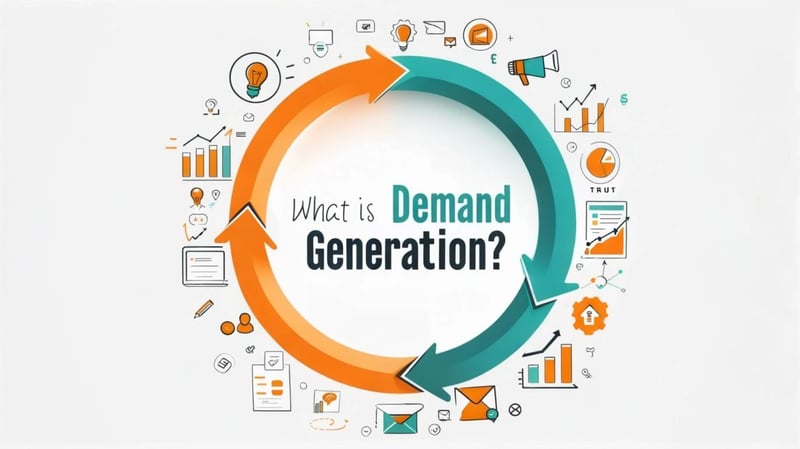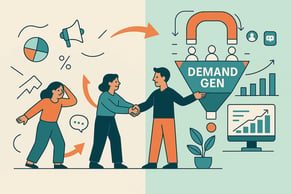What is Demand Generation?

Isn’ t it self- explanatory? Generate the demand!
Demand generation is one of the most widely used yet often misunderstood marketing terms. Businesses hear about it everywhere, but without a clear-cut definition, it’s easy to get lost in the jargon.
The truth is, demand generation is more than just getting leads – it’s about creating sustained interest in your brand, building trust with potential customers, and guiding them through their journey long before they are ready to buy.
Many believe that demand generation is just another term for lead generation, but that’s not quite right. While lead generation focuses on capturing contact details, demand generation is a broader strategy that creates interest, educates prospects, and nurtures them toward becoming customers.
ChatGPT Definition
Demand generation is a marketing approach focused on creating awareness and interest in a product or service to drive high-quality leads for a business. It encompasses strategies, tactics, and campaigns designed to attract, engage, and nurture potential customers throughout their buying journey.
Wikipedia Definition
Demand generation refers to targeted marketing programs that drive awareness and interest in a company’s products or services. It is commonly used in B2B, B2G, and longer B2C sales cycles and involves multiple areas of marketing working together with a structured sales process.
Who invented it?
Interestingly, no one person or company invented demand generation. Instead, it evolved over time as businesses recognized the need for a structured marketing approach that goes beyond just lead capture.
However, its core principles can be linked to the AIDA model (Awareness, Interest, Desire, Action), developed by E. St. Elmo Lewis in the late 19th century. This model, originally created to explain the stages of consumer behavior, aligns well with modern demand generation strategies that focus on nurturing prospects from awareness to conversion.
How should we understand it then?
This is where things get tricky. If marketing experts like Philip Kotler, Seth Godin, or ITSMA had defined it clearly, we would all have a universal understanding. But that didn’t happen.
Instead, different people have created their own definitions and frameworks. Some confuse it with lead generation, while others think demand generation means email marketing, running ads, or attending events. As a result, businesses hear the term and want it – but often don’t fully understand what it entails.
Make it simple
At its core, demand generation is about building awareness and interest in a way that nurtures potential customers. It’s not just about generating leads – it’s about attracting, connecting, targeting, interacting with prospects toward your brand before they are ready to buy.
Why does Demand Generation matter?
Customers today are more informed and selective than ever. They don’t make decisions based on a single advertisement or cold email. Instead, they explore multiple options, conduct research, and look for trusted sources before engaging with a brand. Demand generation ensures that your brand is part of this journey from the very beginning.
Marketing used to be about quick wins – running ads, generating leads, and pushing for immediate sales. But this short-term approach is no longer sustainable.
Demand generation, on the other hand, focuses on building trust, providing value, and creating meaningful relationships with potential customers. Instead of aggressively selling, businesses must attract, educate, and nurture leads, ensuring that when the time comes to buy, their brand is the obvious choice.
Demand Generation in A.C.T.I.O.N
Over the years, with more than two decades of industry experience and a deep understanding of our clients’ needs, one thing became clear – none of the existing demand generation processes fully captured the end-to-end journey of creating and sustaining demand in a way that is both structured and adaptable.
That’s why we created A.C.T.I.O.N.
Built on our expertise and an evaluation of existing approaches, A.C.T.I.O.N. is a natural evolution of everything we’ve learned. It provides a clear, strategic roadmap that aligns marketing efforts with business outcomes, bringing clarity and efficiency to a process that is often fragmented and unpredictable.
Now, let’s take a closer look at what A.C.T.I.O.N. is all about.
-
Attract
The first step is getting noticed by the right people, and this can be achieved through content marketing, targeted campaigns, online ads, SEO, webinars, events, and a well-designed website. The goal is to ensure your audience knows you’re in the market and ready to meet their needs.
-
Connect
To connect with leads, their contact details are essential. This can be gathered through form fills, chatbots, newsletter sign-ups, phone calls, meeting scheduling, social media follows, or purchasing contact lists. Content marketing, email campaigns, social media engagement, and a well-optimized website help build connections.
-
Target
Show why your product or service is the right choice. Share emails, case studies, videos, and helpful content to educate potential customers. Webinars, podcasts, and targeted ads reinforce your message and keep them interested.
-
Interact
Now, it’s about answering questions and building confidence. Offer live chats, free trials, demos, or consultations to help prospects decide. Automation ensures quick responses and keeps the conversation going.
-
Onboard
Personalized offers and reminders help speed up closure. At this stage, engaged and warmed-up prospects are handed over to the sales team, who connect with them to understand their unique needs. To drive conversion, sales teams rely on well-designed landing pages to convey offers and use various types of content to guide prospects step by step.
-
Nurture
Happy customers are your best promoters. Keep them engaged with follow-ups, special offers, and helpful content. Great support and community-building turn one-time buyers into loyal customers. And we help you collect customer feedback too, which is the key to continuous improvement.
Curious about how this all comes together?
We know there’s a lot to unpack, and every business’s journey looks different. That’s why we’ve broken it all down for you. Explore our Demand Generation service to see how we bring strategy to life and create real impact.
Related content worth reading

Demand Generation Marketing Service Provider
Journey from startup chaos to focused demand generation expertise, introducing the A.C.T.I.O.N approach.

ShikhaShikz Marketing turns One
Celebrating one year of ShikhaShikz Marketing with milestones, lessons learned, and growth insights.
